Managing Intravenous Fluid Therapy
Select a Skill:
- » Regulating an Intravenous Infusion
- » Using an Infusion Pump
- » Changing Intravenous Tubing and Fluids
- » Changing Intravenous Dressings
Take the Review Test:

Safety
- Adhere to strict aseptic technique when applying or changing IV site dressings.
- Be aware that transparent dressings are changed during IV site rotation or when they become loose, soiled, or wet.
- Be aware that gauze dressings are changed every 48 hours, or immediately if their integrity is compromised.
- Keep one finger on the catheter until the new tape or dressing secures its placement. If the patient is restless or uncooperative, ask another staff member to assist with the procedure.
- Do not use adhesive bandages on a catheter insertion site. They are neither occlusive nor sterile; using them increases the risk of IV site infection.
Equipment
(Roll cursor over items to see labels)

Antiseptic swabs
Adhesive remover
Skin protectant swab
Clean gloves
Tape
IV site protector
Sterile transparent semipermeable dressing
Sterile 2x2 inch gauze pad
Label for gauze pad
Delegation
The skill of changing a short peripheral IV dressing may not be delegated to nursing assistive personnel (NAP). Before delegating related skills, be sure to inform NAP of the following:
- Instruct NAP to report to you if a patient says his or her IV dressing is moist or loose.
- Instruct NAP to protect the IV dressing during hygiene and other activities of daily living (ADLs).
Preparation
- Determine when the dressing was last changed. The dressing should be labeled to indicate the date and time at which it was applied. Perform hand hygiene. Observe the present dressing for moisture and intactness. If moisture is present, determine whether it is from site leakage or from an external source.
- Make sure the IV system functions properly, with the correct flow rate and without tubing or catheter kinks. Palpate the catheter site through the intact dressing to determine if the site is tender, painful, or burning. If the dressing appears moist, put on clean gloves to palpate the site.
- Monitor the patient’s body temperature.
- Assess the patient’s understanding of the need for continued IV infusion therapy.
Follow-up
- Observe the function, patency, and flow rate of the IV system after changing the dressing.
- Frequently inspect the condition of the catheter insertion site for signs of IV-related complications, such as redness, swelling, and exudate, and assess the patient’s level of pain at the insertion site.
Documentation
- Record the time at which the peripheral IV catheter dressing was changed, the reason for the change, the type of dressing material used, the patency of the system, and a description of the venipuncture site.
- Report to the health care provider any complications such as infiltration or phlebitis noted at the IV insertion site.
Review Questions
1. Which instruction might the nurse give to nursing assistive personnel (NAP) regarding the care of a patient with an intravenous (IV) site dressing?
 “Assess the IV site frequently for signs of inflammation.”
“Assess the IV site frequently for signs of inflammation.” “Be sure not to obscure the insertion site with the dressing.”
“Be sure not to obscure the insertion site with the dressing.” “If the gauze dressing looks damp, replace it with a dry 4 x 4 gauze.”
“If the gauze dressing looks damp, replace it with a dry 4 x 4 gauze.” “Be sure to notify me if the patient reports that the IV site is painful or swollen.”
“Be sure to notify me if the patient reports that the IV site is painful or swollen.”
2. How will the nurse minimize the risk for infection when changing a patient’s IV catheter site dressing?
 Use aseptic technique throughout the process.
Use aseptic technique throughout the process. Pull the tape toward the insertion site.
Pull the tape toward the insertion site. Remove both the gauze dressing and the tape one layer at a time.
Remove both the gauze dressing and the tape one layer at a time. Explain the process to the patient.
Explain the process to the patient.
3. The nurse is concerned that a confused patient’s erratic movements may compromise the intravenous (IV) insertion site. Which action can the nurse take to protect the patient and the site from injury?
 Apply an IV site-protection device over the site, such as House UltraDressing.
Apply an IV site-protection device over the site, such as House UltraDressing. Apply restraints to the patient.
Apply restraints to the patient. Check the patient frequently.
Check the patient frequently. Instruct the patient to avoid dislodging the IV catheter.
Instruct the patient to avoid dislodging the IV catheter.
4. Which action would the nurse take if an intravenous (IV) insertion site appeared red, warm, and swollen?
 Assess for blood return.
Assess for blood return. Discontinue the infusion.
Discontinue the infusion. Change the existing dressing.
Change the existing dressing. Secure the tubing with more tape.
Secure the tubing with more tape.
5. How can the nurse ensure that a patient’s IV tubing will not tug on the infusion catheter after a transparent dressing is applied to an infusion site on the arm?
 Encircle the arm with tape.
Encircle the arm with tape. Secure the tubing and catheter hub with tape.
Secure the tubing and catheter hub with tape. Secure the tubing in two different locations on the arm.
Secure the tubing in two different locations on the arm. Label the dressing with the date and time of application.
Label the dressing with the date and time of application.
You have completed the Review Questions for this skill. To take the Review again select the Start Over button. To proceed to another skill select from the dropdown menu. Select the Home or Back button to proceed to the next section.

